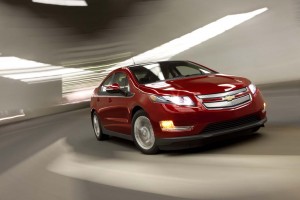
GM hopes it has quelled concerns about with modifications to be made to the vehicle and its battery cooling system.
General Motors isn’t about to give up on the Chevrolet Volt, top company officials insisted this week, despite the battery-electric vehicle getting off to a slow start.
And they said they do not believe the plug-in hybrid suffered serious long-term damage after reports surfaced of fires following government crash tests of the Volt.
Only a “handful or two” of Volts were turned in by customers after GM offered to take them back when the flap over the electric car’s safety surfaced last month, following a crash test by the National Highway Traffic Safety Administration, according to Mary Barra, GM’s vice president of global product development.
The problem – which has not been repeated on the road by actual Volt owners – has been traced back a small leak of battery pack coolant, a situation worsened by the particular NHTSA test procedure, which eventually let the liquid contact a circuit board and, weeks later, short out.
GM has since ordered modifications to the Volt to prevent coolant leakage and ensure that even if something does leak it won’t cause a short. The fix is now being implemented on new plug-ins rolling off the assembly line in Detroit and existing owners will be told to bring their vehicles in for the modifications starting next month.
At the same time, GM has maintained the current schedule for producing the Volt at its Detroit-Hamtramck assembly plant, Barra said. The company plans to produce as many as 60,000 plug-ins for all of 2012, a figure that also includes the Opel Ampera. About three-quarters of that production is earmarked for the U.S.
But Mark Reuss, president of GM North America, cautioned that production will be adjusted to reflect sales, not the other way around. He acknowledged, in an interview, that GM still does not have a clear sense of how much demand there is for battery-electric vehicles.
GM Vice Chairman Steve Girsky, meanwhile, said the maker is intent on filling the distribution pipeline in both the US, Europe — where the Opel Ampera recently went on sale — and in China.
Both the Opel and Volt fell short of sales expectations last year, GM selling only about 8,000 of the Chevey plug-ins in the U.S. But despite the fact that some analysts have written off battery technology as a failure, GM officials remain upbeat.
If anything, they insist that it was more an issue of availability than demand. Production was limited until the latter months of the year and much of the initial supply was dedicated to use as dealer test vehicles. So, only a limited number of Chevrolet dealers actually had cars to sell, Girsky said, adding that, in many parts of the country it was “impossible to get a Volt.”
Girsky declined to give any kind of Volt sales projection for 2012
During separate appearances at the Automotive News World Congress, both Girsky and Barra said GM is still trying to determine the actual customer demand for the technology in the US as well as in Europe and China.
“I can say the Volt is succeeding in bringing in customers that we’ve never seen before. These people are techies. They’re early adopters and customer satisfaction is very high,” Girsky said.

What’s the story behind the accompanying photo? It looks like a Cruze. ReVolting?
I’ve said this before, but as a GM retiree, the cost of a Volt is just leaving me out of the market. It is a small car and overpriced for its size, albeit one I’d love to have. But at $33,000, after Fed tax credit? No way. The price is going to have to come down another $10,000 before a Volt would be feasible for me. For $33,000, I’d rather have a Camaro convertible, even if it isn’t a “green” car like the Volt.
The picture you is a an old preproduction version of a Cruze, not a Volt. The Cruze has a label that states “Volt technology inside”.
Ah, the danger of working on a smartphone to post v a computer, where you can actually see that a mis-marked archive pic is, in fact, a mis-marked archive pic. Thanks for the catch. It has been corrected.
Paul A. Eisenstein
Publisher, TheDetroitBureau.com